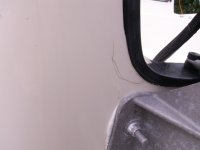I don't quite agree that this is just a cosmetic issue. While I do not think it is structural to the hull it certainly is a design defect in the engineering of the gelcoat/laminate mold geometry on the 2004 CD25. The geometry at this location is definitely a design defect with inadequate radius if left exposed. On my 2004 CD 25 there is clearly not enough radius on the top of the transom where it meets the inner vertical wall to be left exposed. This is why you do not see sharp corners in molded fiberglass products. It is well known that sharp corners in fiberglass laminate will crack the gel coat at the corner's edge unless a substantial radius is designed in.The black molding on top of the transom is an effort to cap the transom. This would work fine, but it is too narrow and leaves some of the top of the transom exposed. From "Anita Marie" 's photo at the start of this thread you can see a larger radius that the factory addresed on later boats after the cockpit design change. On my boat, the gelcoat was cracked on the port side of the engine when delivered and the crack has widened. Another crack has appeared in the gel coat on the starboard side. Engine vibration might have been enough to cause this. The transom's on these boats are massively built and I don't think they flex very much if at all, even if trailered and bumping on the road.
The problem with cracked gel coat is that this gives an oppening for water to migrate into the underlying fiberglass laminate. This is why I keep the cracks taped, pending a more permanent solution. I don't expect the transom to fall off anytime soon, but this is a defective condition that needs more than duct tape to effect a more permanent solution. Maybe an additional molding installed on this edge with 3M 5200 that is somewhat more flexible than just a hard filler/gelcoat repair and might cure the issue permanently.
There was a thread this past winter about a 2003 CD25 for sale in New Jersey, the "Frequent Sea", and one of its problems apparently was moisture in the transom from a cracked transom. I suspect that this cracking issue on top of the transom was the cause of moisture migrating into the transom from these same type of cracks.
I have emailed Bret Reynolds at C-Dory regarding this issue on my boat along with photos and I will discuss with him how they have repaired other boats with this condition since my boat is still under warranty.
In any case, however, if your boat has a crack in the gelcoat you really should seal it to prevent any water getting in and causing any deterioratioin in the laminate under the gelcoat.
Photos are below.
Regards,
Pete in NY






